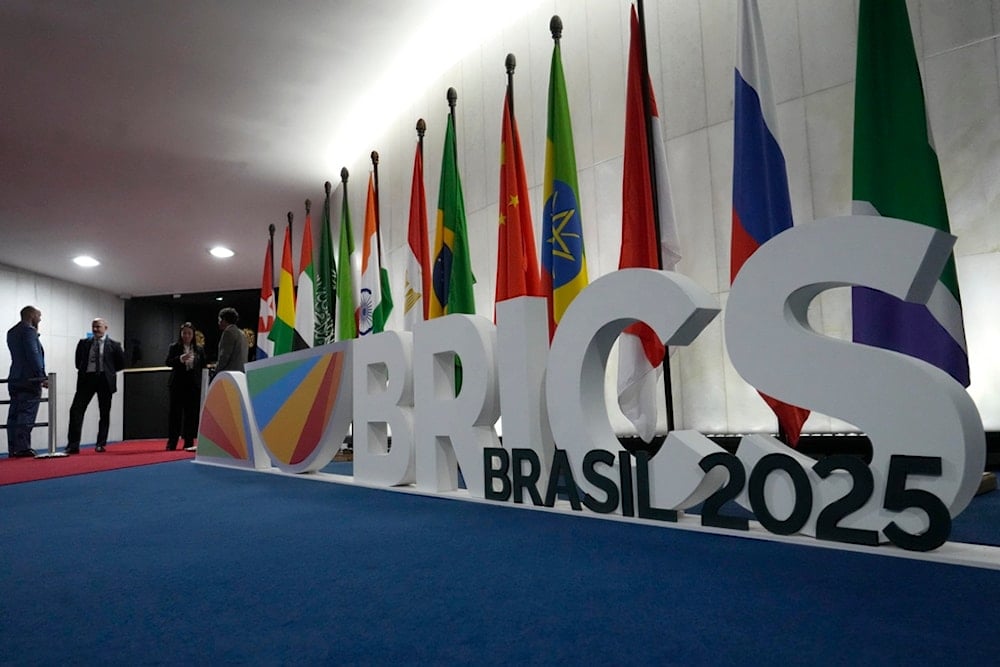BRICS expansion draws Southeast Asia closer to bloc's orbit: FP
The upcoming BRICS summit in Rio highlights the bloc's growing global influence, especially in Southeast Asia, where expanding participation reflects both strategic opportunity and regional tensions over China's role and US threats.
-

A sign announcing the 11th BRICS Parliamentary Forum stands at the entrance to the Federal Senate in Brasilia, Brazil, on Wednesday, June 4, 2025. (AP Photo/Eraldo Peres)
Leaders of the BRICS bloc will convene in Rio de Janeiro on July 6–7 to mark a major expansion of the alliance, one that signals a reconfiguration of global power, the Foreign Policy (FP) reported on Tuesday.
Since 2024, the original five, Brazil, Russia, India, China, and South Africa, have welcomed Egypt, Ethiopia, Indonesia, Iran, and the United Arab Emirates into their ranks. Together, the expanded group now accounts for nearly 40% of global GDP (by purchasing power parity), outpacing the G7's 30% share.
According to the FP, the presence of Southeast Asian states at this year's summit represents a turning point. Although the region has long remained on the sidelines of BRICS activities, that is beginning to change. Indonesia joined in January, and Malaysia, Thailand, and Vietnam have agreed to take part as partner countries. Their growing interest reflects a broader shift in the group's stature, from an informal dialogue platform to a more structured and attractive multilateral body.
Moreover, BRICS initiatives such as the New Development Bank (NDB) and the Contingent Reserve Arrangement (CRA) are drawing attention. The NDB could offer new sources of infrastructure and green development financing, allowing countries to diversify beyond traditional lenders. Meanwhile, the CRA offers short-term liquidity support for central banks dealing with emergencies or currency instability.
Strategically, participation also offers symbolic weight, enabling smaller states to stake out space in a multipolar order while resisting pressure from either side of intensifying US-China competition.
"Participation gives them the opportunity to engage in cooperative multipolarity on the one hand and express their aversion to intensifying great-power competition on the other—even though BRICS is co-led by China and Russia and viewed in many Western capitals as anti-Western," FP wrote.
BRICS meets ASEAN
Southeast Asian countries also see BRICS as a vehicle to strengthen their South-South cooperation strategies. Even though Russia is not technically part of the global south, rising powers like Brazil, China, and India are helping accelerate a post-unipolar world order. In turn, that offers alternatives for countries wary of overdependence on either Washington or Beijing, especially as tensions grow over flashpoints like Taiwan.
That said, not all ASEAN members support deeper BRICS involvement. In countries like the Philippines and Singapore, and even among BRICS-affiliated states like Indonesia and Vietnam, there are concerns that China's influence in the bloc could spill into ASEAN affairs, FP wrote.
Maritime disputes in the South China Sea, for instance, remain sensitive. "Manila and Hanoi, for instance, would not want Beijing to gain any more leverage over ASEAN-led negotiations to establish a legally binding code of conduct in the South China Sea," Foreign Policy noted.
Read more: Medvedev proposes BRICS intl. court as alternative to 'flawed' ICC
As BRICS deepens ties with individual ASEAN members, it risks weakening ASEAN's cohesion from within. According to FP, some observers warn that this could dilute the bloc's ability to act collectively, especially as other regional alliances like the Quad and AUKUS gain influence.

 3 Min Read
3 Min Read









